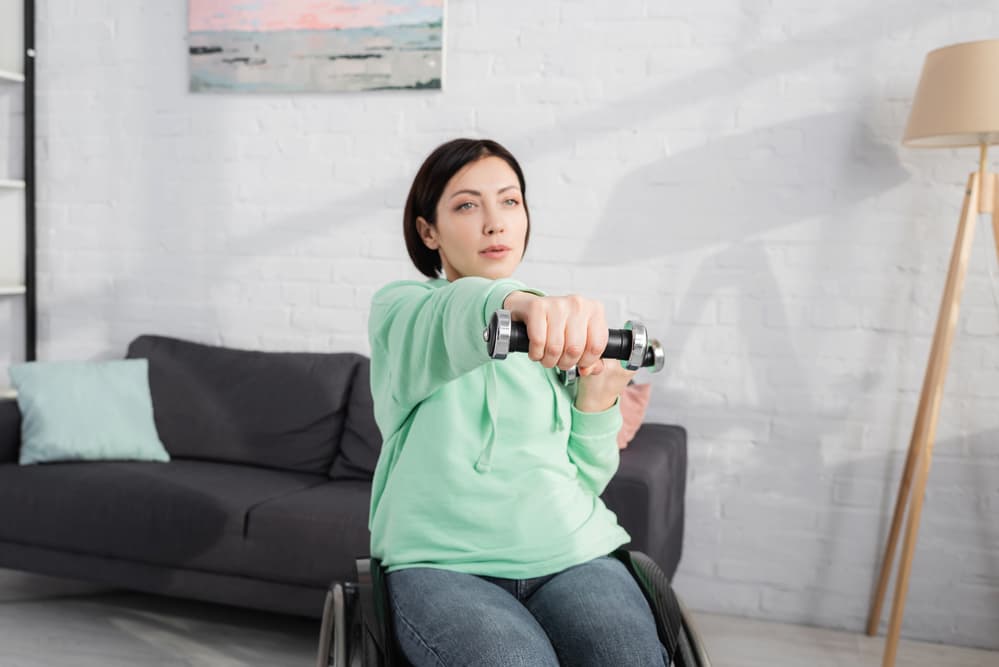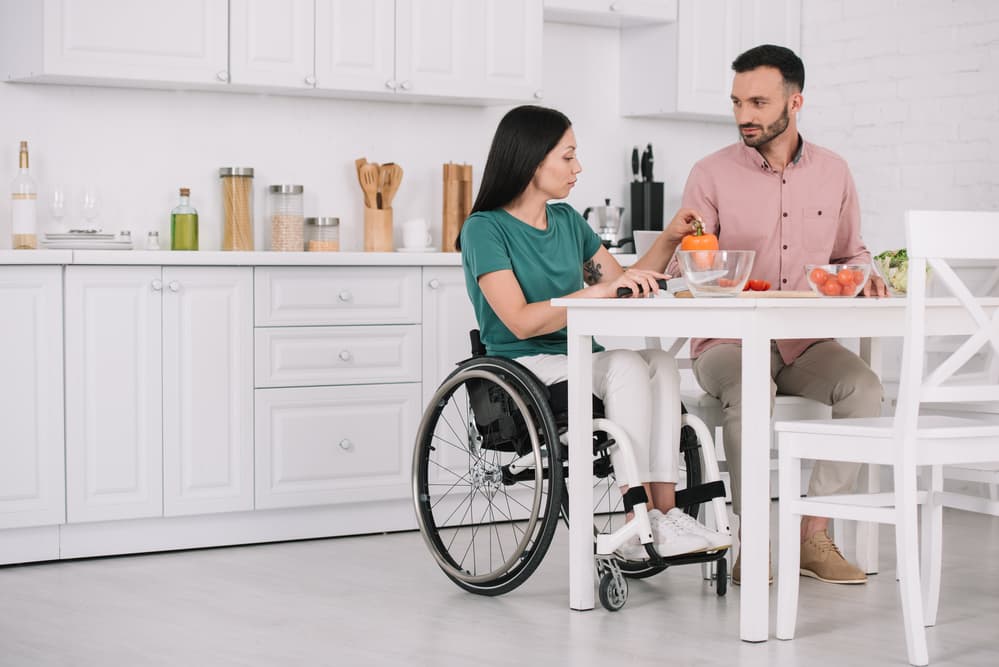Losing weight is not an easy task. But in the case of anyone in a wheelchair, with many restrictions that involve almost every area of their lives, losing weight is quite a challenge for them.
Being overweight also increases their risk for various major health disorders, such as cardiovascular disease and type 2 diabetes.
But that doesn’t make it impossible. There are several ways to be active and fit.
Experts’ opinions about losing weight
The video introduces the concept of weight loss when you can’t walk with a multidisciplinary approach to nutrition, exercise, and weight training.
A dietician, Dr. Kat Barefield, says that cutting calories or eating less is the most effective way to lose weight. You just need to eat fewer calories than that quantity.
Find the perfect diet based on your needs. Jacobus TenBroek, a certified personal trainer, says that diet is the main factor in reducing body weight. You then require exercise. If you can, do attempt wheelchair-accessible sports like judo, jujitsu, basketball, wheelchair boxing, or others.
Try to cut what you can. Jonathan Penny from the National Academy of Sports Medicine states that the best strategy to lose weight while in a wheelchair is to consume fewer calories, as metabolism is slower than before, and your body doesn’t need much energy. But make sure you only take out so many calories that you get starving.
How to Boost weight loss in a Wheelchair
If you’re having trouble losing a few pounds, here are a few marvelously efficient methods to lose weight without standing up.
- Work with a healthcare professional
The first step toward weight loss is to consult with your doctor.
Working with a health professional, like a physical therapist or personal trainer, helps make a safe and effective training plan.
The same is valid for diet: eating healthy foods and avoiding larger portions has effectively aided in weight loss. This can be done with the help of a registered dietician or nutritionist.
- Eating Fewer Calories
If you use a wheelchair, you will most likely require fewer calories than those required by a non-disabled person since 50% of muscles are found in the legs, and you won’t be able to use them as much.
To lose weight healthily and gradually, reduce your caloric intake by 250 to 500 calories daily. And you may lose between 0.5 and 1 pound every week.
A certified dietician can count how many calories you require in your daily routine and tell you portion sizes for food.
But don’t go over 1,200 calories in a day, as eating less than 1,200 calories will hinder you from losing weight, send your body into starvation mode, and make weight loss more difficult.
- Healthy Food Habits
If you want to lose weight, adopting healthy eating habits and making healthy choices can help you greatly. Such as
- Eat healthy foods – Eat from 5 food groups, including dairy, whole grains, proteins, fruits, and vegetables, daily because it includes a high amount of viscous fiber, which can prevent overeating and help reduce hunger.
- Eat on a smaller plate, as eating on larger ones can make a portion appear smaller, allowing you to pile on extra food and gain more weight. Putting more healthy items on bigger plates and less nutritious foods on smaller plates can be helpful.
- Using red plates is a new approach to controlling calorie intake. Data suggests that this strategy is effective as humans may presume the red sign as a warning to cut calories.
- Junk food is the enemy of weight loss. Avoid unhealthy foods like bread, baked goods, or junk foods like burgers or potato chips. Substitute them with healthy whole grains, fruits, and fiber.
- Increase proteins – According to various research, increasing protein consumption can contribute to weight loss independent of counting calories and exercising. According to studies, increasing protein consumption can contribute to weight loss independent of counting calories and exercising. Chicken breasts, salmon, Greek yogurt, lentils, quinoa, and almonds are all foods high in protein.
- Snack often – It has been found that snacking on smaller meals and nutritious snacks can keep you going all day rather than relying on a few huge meals.
- Chew food properly – Eating properly accounts for 75% of the weight reduction equation.
It has been found in a couple of studies that fast eaters are more likely to put on weight than slower eaters.
That is why it is essential to chew your food correctly, which can help to lower calorie intake, have a better appetite, and have smaller portions, ultimately preventing weight gain.
- Burn calories with exercise
Weight reduction for wheelchair users can be challenging since they cannot exercise in the same way that non-disabled people can.
The good news is that working out or exercising can be done in a different way for everyone!
Because the body never stops burning calories, even bedridden people can lose weight by exercising.
According to the US Physical Activity Guidelines for Adults with Disabilities, individuals who use wheelchairs should engage in at least 75 minutes of intense aerobic activity or 150 minutes of moderate-intensity exercise per week to maintain weight loss purpose.
Exercises that increase the heart rate include weight training, upper body exercises, an abs and core workout, and yoga; all are beneficial for aiding weight loss in people with limited mobility.
Start small if you can only commit to 10 minutes at first. Aim for two or three workouts every day. Work your way up to 30 minutes or more gradually.
- Upper-body workouts are your best friends

You cannot do a whole-body workout due to limited wheelchair mobility, but specific exercises can help you in many ways, such as
- Increasing your strength, endurance, and flexibility,
- It helps you lose weight,
- Reducing joint or muscle discomfort,
- You are enhancing the range of motion and toning your muscles.
Plenty of workouts can be done to strengthen the body for anyone in a wheelchair, such as bicep curls, chest presses, abdominal twists, rollers, kettlebells, etc.
But always perform a warm-up, stretching, and a cool-down after the workout.
Toms Jankovskis, another T12 paraplegic, shares his workout routine with a complete upper body workout.
- Avoid Fad diets
Fad diets harm your metabolism over time. As a result, cutting calories will be even more difficult in the long run.
Avoid juice cleanses, cabbage soup, and other toxic diets if you are serious about losing weight.
- Hydrate
It’s something everyone says, and it’s true! As necessary as it may be to follow a diet plan, drinking lots of water will aid in flushing out unwanted fat.
When your body is adequately hydrated, it performs significantly better.
It has been found that over 12 weeks, those who drank water before each meal lost 44% more weight than those who did not.
Drink lots of water to lose weight, and avoid sugary drinks as they contain high amounts of liquid calories, making it hard to maintain a healthy weight.
Good options to achieve hydration include water, green tea, and coffee.
- Eat with focus

If you eat without paying attention to what you’re eating, you’re more likely to consume more calories than necessary.
Practicing mindful eating by intentionally restricting your gadget use has been found to help you lose weight, allowing you to eat substantially less while still feeling satisfied.
A review of 24 studies found that eating with distractions such as watching tv can cause 10–25 % more food intake, leading to weight gain.
- Keep a log.
Being accountable for your food intake plays a huge role when you want to lose weight.
So, keeping a log of what you eat and when you eat is one approach to staying motivated.
According to recent research, participants who kept a food diary six days a week lost twice as much weight as those who kept one day a week or fewer.
Fortunately, there are now more smartphone applications than ever that make it simple to keep track of calories consumed, allowing you to make healthier decisions and enhance your overall health.
Choose one that meets your needs, and then begin tracking.
- Sleep is important.
Poor sleep is associated with increased appetite-inducing hormones such as ghrelin, indirectly making you crave more high-calorie foods.
Other research has shown that sleeping less when dieting might impede weight loss and stimulate overeating.
But having enough sleep will benefit the weight loss journey as it was found that an average daily calorie reduction of 270 calories was observed with people who had adequate sleep.
- Sports.
Regarding wheelchair sports, there are many alternatives to choose from.
With appropriate equipment and supervision, swimming can be a terrific workout for your complete body and lower the pressure imposed on your joints. Still, basketball can give your exercise a competitive edge, exercising your arms and shoulders and strengthening your strength.
Other sports that can be used are table tennis, track and field, and handcycling.
- Don’t Stress Out!
Using a wheelchair can put you under a lot of stress and affect your mental health, similar to poor sleep.
If you want to reduce weight, experiment with different stress-management approaches. Such as focusing on finding things you can enjoy rather than worrying about the activities you can’t.
Stress can be reduced by meditation, counseling, journaling, and practicing deep breathing exercises.
There are many easy modifications you can make to your lifestyle that will have a positive impact on your weight.
Nonetheless, you should only dive into some of these options. Try out one approach, and if that one doesn’t pan out, go on to the next.
What people say about losing weight in a wheelchair
In this video, Van Esa, a woman who used a wheelchair, shares her weight loss experience. She says that she focuses on upper body strength and avoids animal and dairy products in her diet. In the end, at 10:00, she shows her before and after pictures to motivate the viewers.
This video shares the journey of Kasey, a person with paraplegia who lost 15 pounds by taking help from a dietitian, eating fewer carbs, and increasing her protein intake while exercising three times a day.
Before you Go
When people are asked where they desire to lose weight and reduce the fat percentage on their bodies, “my belly” is a typical response because it is tough to eliminate abdominal fat, even more so when you cannot walk.
Even when the rest of your body loses weight during weight loss, your abdomen usually retains fat. Read my article on how to lose belly fat in a wheelchair.
In another article, we’ve compiled a nice list of basic wheelchair workouts to offer some ideas of what you may do to get your blood pumping and muscles working.

